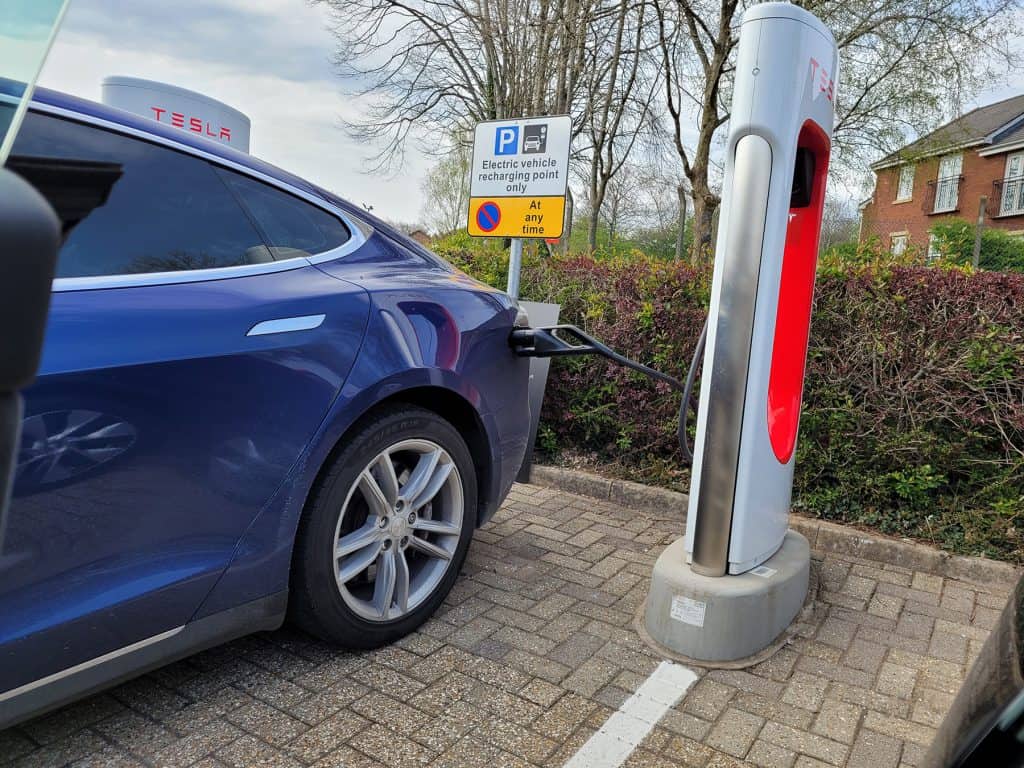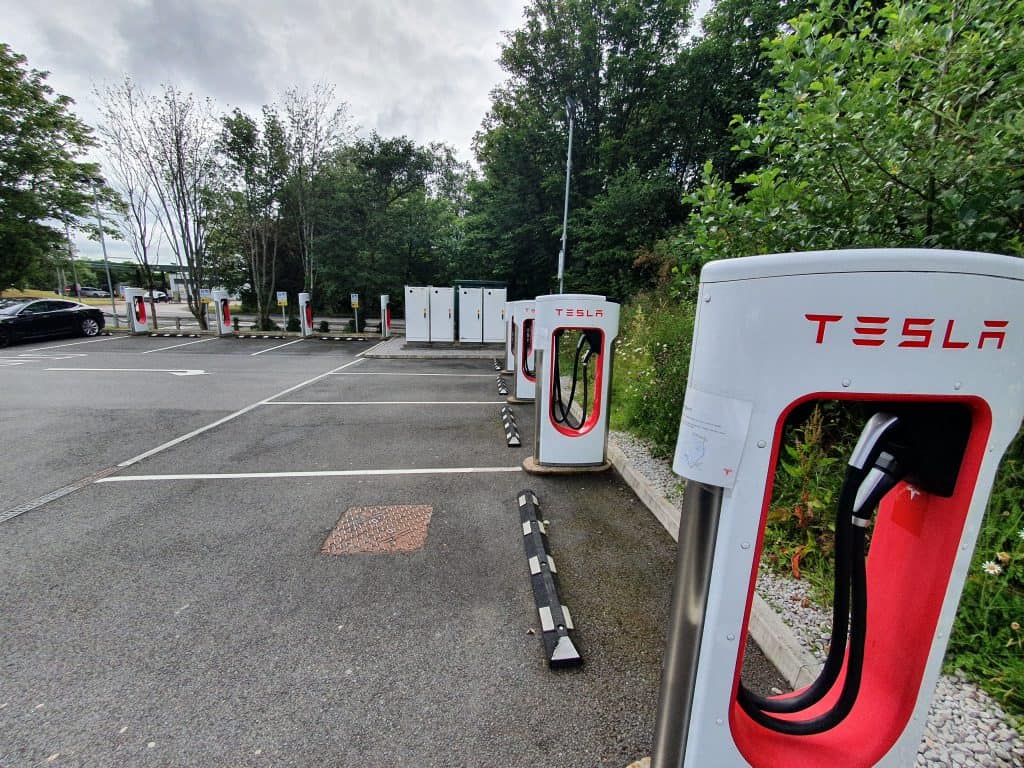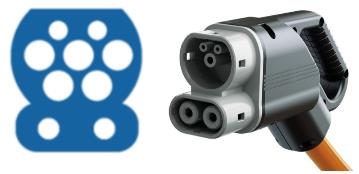If you have looked around for information on electric car charging stations and plugs, you might have come across a range of different terms: level 1, level 2, type 1, type 2, level 3 and 4… CHAdeMO, CCS, Commando, GB/T, Combo 2, Combo 1… fast charge, slow charge, rapid charge, supercharger… confused? I was too!
So I have written this guide to present the required information in an easier-to-understand format.
The Basics: Level 1-4 (Charge Speeds)

We’ll start off by describing what level 1-4 and fast/slow/rapid/super charge mean. Thankfully, it’s quite straightforward: they just refer to the speed of charging:
- Level 1 or Slow Charging: this is the slowest form of charging and should be ‘avoided’ if possible (as in, you wouldn’t want to use a level 1 charger in the middle of a long journey). In general, plugging your EV into a standard home socket (e.g. a 2-pin socket in American homes, or a 3-pin socket in UK homes) is level 1/slow charging.
Some older charging stations also have this form of level 1 charging available. This might be suitable for charging your EV overnight, or potentially charging up your PHEV with its smaller-capacity battery. Level 1 charging is usually at 3 kW/120-volts. - Level 2 or Fast Charging: this is the more normal form of EV charging found in public areas, and also at homes where a dedicated charging point has been installed. These will charge at more than double the rate of a level 1 charger, and run at 240 volts and anything from 7 kW to 22 kW charge power.
Depending on the specific car, a 7 kW charger can charge up a car to 80% in 3-5 hours, compared to 1-2 hours at 22 kW. - Level 3, Level 4 and Rapid Charging: this is where some of the confusion creeps in. So anything which can charge a car in minutes not hours comes under the level 3/4 or ‘rapid charging’ bracket. This is done via 43 kW or 50 kW charge rates from DC power (compared to the earlier types which is more frequently AC power).
One caveat, however, is that some of Tesla’s supercharger network runs at 120-150 kW (with some newer stations offering 250 kW speeds) – and so some people refer to this as level 4 charging (and all other non-Tesla rapid charging stations as level 3).
Okay, so that’s hopefully clear enough: most charging stations offer at least level 2 charging, although higher speed chargers are becoming more popular. This is especially true due to the number of new Electrify America and Tesla Supercharger locations being installed across America, which tend to offer rapid chargers.
The Basics: Charge Plug Types For L2 Charging
The actual type of charge plug gets a little more complicated, because there’s historically not been much agreement between car manufacturers and countries. Plus the level (aka speed) of charging also dictates what charge plug/connector is used.
Before we go into specifics, it’s worth pointing out that you often can get adapter and converter cables – so even if your car has a particular type of plug whilst the charging station has another type, you can use a converter cable. So don’t worry too much about the specifics, just know that in addition to the 2 charging cables your EV should come with, you might need to buy an extra cable or two in the worst case.
Okay, so Type 1 is the most normal plug type. Its technical name is the SAE J1772, but it’s also called a J plug. This 3-pin plug is standard in America and Canada, but cars like the Japanese Nissan Leaf also have the type 1 inlet. It looks like:

In competition with this is the type 2 plug, which is more commonly seen in Europe – but Tesla also use this (albeit a slightly modified version which accepts higher charging levels). This 7-pin plug looks as follows:

Most charging stations (be it public ones or dedicated at-home ones) – aka level 2 ones – use either type 1 or type 2 plugs, and pretty much every EV will come with a type-2-to-1 (or type-1-to-2) cable… so for the most common charging purposes, you have almost learnt all you need to know!
Congratulations! However if you want to delve into the World of rapid charging, feel free to read on!
Charge Plugs For Rapid Charging (L3-L4)

Okay, so type 1 and type 2 connectors/cables generally run at 7-22 kW (apart from Tesla’s modified type 2 charger) – aka level 2 charge rates. But naturally, being able to charge an EV in minutes is a big advantage – hence the need rapid charging (level 3/4).
These require different types of plugs, however, and so we have two more to introduce: the German-created CCS format, and the Japanese-backed CHAdeMO.
The CCS is a 5-pin plug from Germany, but also backed by various American car manufacturers and charging networks. These tend to go up to 50 kW and are seen in the majority of EVs including the Chevy Spark, VW e-Golf and BMW i3:

The CHAdeMO is a more complex 10-pin plug from Japan, and up until 2020 it was the most commonly found rapid-charging connector within the UK. The Nissan Leaf uses this connector type for its rapid DC charging inlet, and CHAdeMO also tends to be seen up to 50 kW:

Due to how differently they work, it is not possible to buy a CCS-to-CHAdeMO (or CHAdeMO-to-CCS) adapter.
This is starting to become a downside for people with CHAdeMo EVs, such as the Nissan Leaf, because an increasing number of charging stations are dropping CHAdeMo. In time, this will make it harder and harder to charge up with a CHAdeMo-based EV.
Note: all the above applies to non-Tesla owners. If you are a Tesla owner, however, the situation is a bit more complicated. Some older Teslas use a modified type 2 plug for supercharging. Other Teslas might use CCS plugs, whilst in some countries they instead support CHAdeMo. Basically it’s a bit more complicated with a Tesla, but you should have all the cables and adapters you need when you take delivery of your new Tesla.
We’ll give a final mention of GB/T, which is a China-only rapid charger which might run to 900 kW in the future. This is still in development and will be restricted to China however, so don’t worry too much about GB/T unless you plan on living in China!
To Conclude
We hope you have found this article useful. There are a lot of terms flying around, but we have mentioned all that you generally need to know when buying a fairly mainstream electric car.
The main thing to remember is that for standard (level 2) charging, you won’t have an issue whether your car has a type 1 or type 2 inlet because you can get an adapter.
Rapid charging is more diverse, but if you use your car’s in-built infomation system – or your EV’s accompanying app – you will be directed to the nearest compatible rapid charging station for your vehicle.
2 comments
What are the 5 pins used fo on an SAE J1772 plug?
Hi Marc, this website lists them (along with some helpful technical diagrams) but they are: AC lines 1 and 2, ground, control pilot and proximity detection.